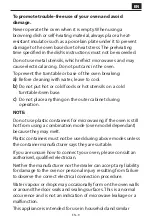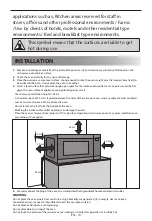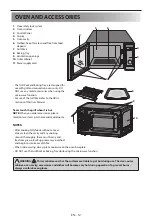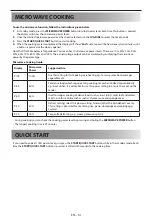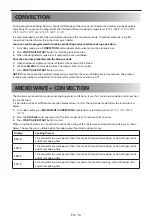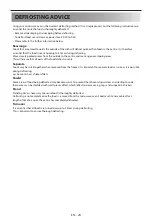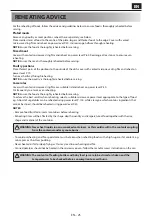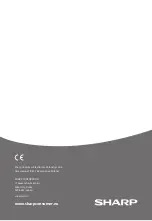
EN
EN – 20
EN – 20
CLEANING AND CARE
• Turn off the oven and unplug the power cord from the mains supply when cleaning.
• Keep the inside of the oven clean. When food splatters or spilled liquids adhere to oven sides, top or baseplate,
wipe with a damp cloth. Mild detergents may be used if the oven gets very dirty. Avoid using spray or other harsh
cleaners. They may stain, streak or dull the door surface.
• The outside of the oven should be cleaned with a damp cloth. To prevent damage to the operating parts inside the
oven, water should not be allowed to seep into the ventilation openings.
• Wipe the door and window on both sides, the door seals and adjacent parts frequently with a damp cloth to remove
any spills or spatters.
• Do not use abrasive cleaners.
• Do not steam cleaners.
• Do not allow the control panel to become wet. Clean with a soft, damp cloth. When cleaning the control panel, leave
oven door open to prevent oven from accidentally turning on.
• If steam accumulates inside or around the outside of the oven door, wipe with a soft cloth. This may occur when the
microwave oven is operated under high humidity condition. This is not a fault.
• The baseplate should be cleaned regularly to avoid contamination and potential arcing/damage. Simply wipe the
bottom surface of the oven with mild detergent.
• Remove odors from your oven by combining a cup of water with the juice and skin of one lemon in a microwaveable
bowl. Microwave for 5 minutes. Wipe thoroughly and dry with a soft cloth.
• If the light bulb fails, please contact customer service for advice.
• The oven should be cleaned regularly and any food deposits should be removed. Failure to maintain the oven in
a clean condition could lead to deterioration of surface that could adversely aff ect the life of the unit and could
possibly result in a hazardous situation.
• Please do not dispose of this appliance into the domestic rubbish bin; refer to your countries advice on disposal of
this type of product.
EN – 21
EN – 21
SUITABLE OVENWARE
1.
The ideal material for a microwave utensil is transparent to microwave, it allows energy to pass through the
container and heat the food.
2.
Microwave cannot penetrate metal, so metal utensils or dishes with metallic trim should not be used.
3.
Do not use recycled paper products when microwave cooking, as they may contain small metal fragments which
may cause sparks and/or fi res.
4.
Round /oval dishes rather than square/oblong ones are recommend, as food in corners tends to overcook.
5.
Narrow strips of aluminum foil may be used to prevent overcooking of exposed areas. But be careful don’t use too
much and keep a distance of 2.54 cm between foil and cavity
The list below is a general guide to help you select the correct utensils.
Cookware
Microwave
Safe
Grill/
Convection
Comment
Browning dishes
/
Always follow the manufacturers instructions.
Do not exceed heating times given. Be very careful as these
dishes become very hot.
China and ceramics
/
Porcelain, pottery, glazed earthenware and bone china are
usually suitable, except for those with metallic decoration.
Heat–Resistant Glass
Care should be taken to ensure that any glass cook ware is
suitable for use in a microwave oven.
Non Heat–Resistant Glass
Heat–Resistant Ceramics
Ensure that any ceramic material is not too thick or in high in
mineral content.
Microwave–Safe Plastic Dish
Always check that the plastic cook ware is suitable to be used in
a microwave oven.
Kitchen Paper
/
Only use kitchen paper which is recommended for use in
microwave ovens.
Glassware e.g. Pyrex®
/
Care should be taken if using fi ne glassware as it can break or
crack if heated suddenly.
Metal Tray
It is not recommended to use metal cookware as it will arc,
which can lead to fi re.
Metal Rack
It is not recommended to use metal cookware as it will arc,
which can lead to fi re.
Aluminium foil
Foil Containers
/
Small pieces of aluminium foil can be used to shield food from
overheating. Keep foil at least 2.54 cm from the oven walls, as
arcing may occur.
Foil containers are not recommended unless specifi ed by the
manufacturer, e.g. Microfoil®, follow instructions carefully.
Cling fi lm
It should not touch the food and must be pierced to let the
steam escape.
Plastic/Polystyrene e.g fast food
containers
Care must be taken as some containers warp, melt or discolour
at high temperatures.
Freezer/Roasting bags
Must be pierced to let steam escape. Ensure bags are suitable
for microwave use.
Paper - Plates, cups and kitchen
paper
Do not use plastic or metal ties, as they may melt or catch fi re
due to the metal ‘arcing’.
Straw and wooden Containers
Only use for warming or to absorb moisture.
Care must be taken as overheating may cause fi re.
Recycled paper and newspaper
Always attend the oven when using these materials as
overheating may cause fi re.
May contain extracts of metal which will cause ‘arcing’ and may
lead to fi re.
WARNING: When heating food in plastic or paper containers, monitor the oven due to the possibility of
ignition.
NOTE:
Do not leave your oven unattended while in use.
Содержание YC-QC254A
Страница 30: ...EN 28 EN 28 ...
Страница 31: ......



